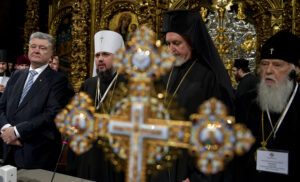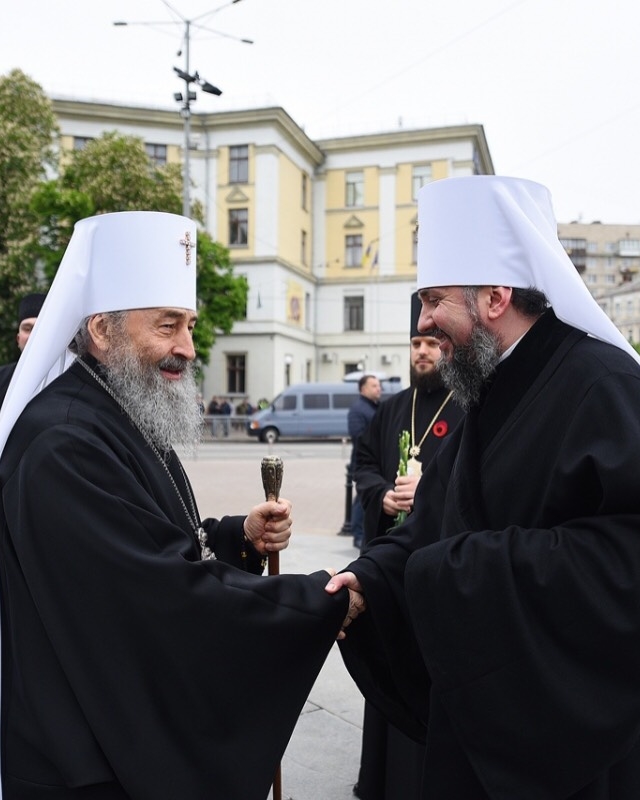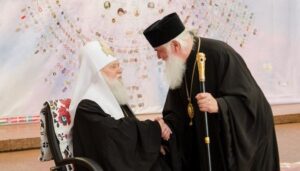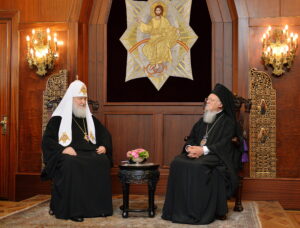Even before the current war, the landscape of Orthodoxy in Ukraine was incredibly complicated, and any attempt to summarize it will inevitably fail to do the subject justice. This is compounded by the fact that it’s nearly impossible to avoid bias. If I refer to the head of the “Orthodox Church of Ukraine” (OCU) as Metropolitan Epiphany, some will say that I am pro-OCU because I recognize him as a real metropolitan. If I put quotation marks around his name (“Metropolitan Epiphany” or “Metropolitan” Epiphany), the assumption will be that I am pro-Moscow and reject the canonicity of the OCU. If I use the spelling Kiev or Kyiv, it’s assumed to say something about my political leanings. For the sake of this summary, I’m going to refer to individuals by the titles that they claim for themselves, without taking an open position on the legitimacy of those claims. And I’m going to use place names (e.g. Kiev) that were commonly used in mainstream English-language publications prior to recent events.
At the beginning of 2018, three major groups existed in Ukraine claiming to be Orthodox:
- The Ukrainian Orthodox Church, an autonomous church under the Moscow Patriarchate (UOC-MP), led by Metropolitan Onuphry Berezovsky.
- The Ukrainian Orthodox Church of the Kiev Patriarchate (KP), led by Patriarch Filaret Denisenko.
- The Ukrainian Autocephalous Orthodox Church (UAOC), led by Metropolitan Makary Maletich.
At that time, all of the world’s Orthodox Churches recognized only the UOC-MP as canonical. The other two groups were considered schismatic.
Both the KP and UAOC were created in the early 1990s, in the context of the fall of the USSR and the independence of the Ukrainian state in 1991. At that time, the canonical Orthodox Church in Ukraine was known as the Ukrainian Exarchate of the Russian Orthodox Church, under the Moscow Patriarchate. The Exarchate was headed by then-Metropolitan Filaret Denisenko, who had been Metropolitan of Kiev since the 1960s. Filaret was a controversial figure – frequently thought to be a KGB collaborator who aspired to become Patriarch of Moscow, and who, in the early 1990s, was the subject of a scandalous expose: he had allegedly lived with a woman for many years and fathered multiple children, despite his vow of celibacy. When the Patriarch of Moscow died in 1990, Filaret was appointed locum tenens and expected to be elected the next Patriarch, but he lost the election to Alexy II.
After this, and following the establishment of an independent Ukrainian state, the Ukrainian Exarchate, led by Filaret, requested autocephaly from the Moscow Patriarchate, but this was denied. (Notably, the current leader of the UOC-MP, Metropolitan Onuphry, was one of the bishops who signed the request for autocephaly.) Metropolitan Filaret was asked by the MP Holy Synod to resign as Metropolitan of Kiev. He initially agreed, but upon returning to Ukraine he repudiated the resignation, stating that it had been done under pressure, and he was suspended and subsequently defrocked by the Moscow Patriarchate. While Filaret now alleges that this was in retaliation for his attempt at autocephaly, he was also charged with serious canonical offenses (i.e., alleged sexual activity). His deposition and defrocking were accepted by all of the Orthodox Churches, including the Ecumencial Patriarchate, which explicitly acknowledged the MP’s standing to do so. Filaret and a fellow bishop of the MP went into schism, creating their own jurisdiction, which called itself the Kiev Patriarchate. Although they were defrocked by the MP, these two bishops consecrated more bishops for the KP, creating a line of hierarchs tracing their apostolic succession back through the two former MP bishops. In 1997, the MP anathematized Filaret, an action that was accepted and recognized by the EP.
The UAOC was created at basically the same time. There had been earlier groups, in the 1920s and 1940s, that also used the UAOC name, and the modern UAOC viewed itself as the inheritor of their mission. Portions of those earlier iterations of the UAOC migrated to America, and the first Patriarch of the revived UAOC in Ukraine in the 1990s was Mstyslav, who had received a canonically legitimate consecration in the 1940s and is an important figure in the history of the Ukrainian Orthodox Church of the USA. The major difference between the UAOC and the KP in recent decades has to do with apostolic succession: most (or at least, many) of the UAOC bishops appear to trace their lineage back to consecrators who themselves lacked any viable claim to apostolic succession. For example, the 2018 head of the UAOC, Metropolitan Makary, was consecrated by three “bishops,” only one of whom had a canonically-valid apostolic succession (i.e., consecration by at least two bishops who themselves had apostolic succession). The other two consecrators of Makary were “self-ordained,” i.e., non-bishops who simply dressed up as bishops.
As for the Ukrainian Exarchate, after denying its request for autocephaly, the MP granted it an extensive degree of autonomy, reorganizing it into the UOC-MP of today. The UOC-MP’s autonomy is such that it is, in some respects, more independent than some autocephalous churches. It has its own Holy Synod, elects its own primate (who is confirmed by the MP), canonizes its own saints without MP approval, and operates its own Department of External Church Relations. The current leader of the UOC-MP, Metropolitan Onuphry, is universally respected throughout the Orthodox world as a man of integrity and even holiness. In 2014, and again in 2022, he has openly opposed Russian military aggression in Ukraine and defended the borders of the Ukrainian state. It’s notable that the Donbass region and the Crimea remain part of the UOC-MP and have not been handed over to the MP proper.
***

(L-R) Ukrainian President Petro Poroshenko, Metropolitan Epiphany, Metropolitan Emmanuel (EP), and Patriarch Filaret, at the 2018 Unification Council of the OCU
In 2018, the Ecumenical Patriarchate took two major steps:
- The EP rescinded a 17th-century document that had granted jurisdiction over part of what is now Ukraine to the Moscow Patriarchate. The borders of this old territory are not identical with the territory of the modern Ukrainian state, but in any case, the EP’s position was that it was taking back its old powers in Ukraine. Based on this rationale, all bishops in Ukraine were now EP bishops.
- The EP declared that the hierarchs, clergy, and faithful of the KP and UAOC were hereby legitimized, no longer schismatics, and that their holy orders were recognized – their bishops were bishops, their priests were priests, etc.
The EP then organized a “Unification Council” in Kiev to bring together all of the Orthodox jurisdictions in Ukraine and form a new, unified church. The hierarchs of all three jurisdictions were invited. Both the KP and UAOC attended in full force, but only two of the nearly one hundred UOC-MP bishops (up to now, the only canonical bishops in Ukraine) came. One of the two UOC-MP bishops who attended the council was a controversial figure who had been accused of serious moral transgressions and was, by many accounts, looking for a way out. The Unification Council was chaired by Metropolitan Emmanuel (then of France, now Chalcedon), who represented the Ecumenical Patriarch, and also included the active participation of the then Ukrainian President Petro Poroshenko. The council elected as primate of the new church a young KP bishop named Epiphany Dumenko, who was a protege of Patriarch Filaret (who himself was not recognized by the EP as a patriarch, but was given the title “Honorary Patriarch” by the new church). Soon after this, in January 2019, the Ecumenical Patriarchate issued a Tomos of Autocephaly to the new “Orthodox Church of Ukraine” (OCU).
In conjunction with the creation of the OCU and the Tomos of Autocephaly, the EP signed an agreement with the Poroshenko government in Ukraine. Among other things, this agreement provided for the EP to take control of a major cathedral in Kiev, which would serve as a headquarters for an EP Exarchate in Ukraine. This Exarchate, led by an EP bishop, would not be subordinate to the OCU but would directly report to the EP.
In response to these events, the Moscow Patriarchate “broke communion” with the EP. This term, “breaking communion,” is ambiguous and means multiple things. Initially, Moscow did what amounts to breaking diplomatic relations with the EP – removal of the Ecumenical Patriarch’s name from the diptychs, a ban on concelebration of MP clergy with EP clergy, and withdrawal from Pan-Orthodox initiatives involving the EP. Very soon after this, though, as the situation continued to escalate, the MP took the bigger step of banning its faithful from partaking of communion in EP churches, and from EP faithful from partaking of communion in MP churches. This more extreme break in communion is much less common historically, and from the MP’s perspective at the time, was largely aimed at making it clear to the UOC-MP faithful in Ukraine that they should not under any circumstances attend the churches of the OCU.
There seems to have been an expectation on the part of the EP and OCU leadership that many UOC-MP bishops, clergy, and parishes would immediately switch over to the new church structure. In fact, this did not happen. Other than the two UOC-MP bishops who participated in the Unification Council, no other bishops have joined the OCU. A small percentage of UOC-MP parishes switched – the exact number is disputed, as the UOC-MP claims perhaps 200 losses while the OCU claims that it received around 600 new parishes. The UOC-MP alleged that some parishes were forcibly taken from it with government support, with property deeds being changed without approval, etc., despite a public call by Metropolitan Epiphany to his followers not to seize churches but to let people freely join the OCU. In any case, even taking a high estimate, the UOC-MP lost relatively few parishes: it still has about 12,000 parishes, compared to around 7,000 for the OCU.
“Honorary Patriarch” Filaret soon became dissatisfied with the arrangement of the OCU, and he declared the revival of his Kiev Patriarchate jurisdiction. He brought some bishops with him and has since consecrated more bishops and has received Greek Old Calendarist hierarchs into his jurisdiction. Thus, today there are once again three jurisdictions in Ukraine, not counting the EP Exarchate:
- UOC-MP, which remains the largest,
- OCU, and
- KP.
In the months following the formation of the OCU, a few Orthodox Churches in addition to the EP recognized it: the Patriarchate of Alexandria and the Church of Greece, as well as the Archbishop of Cyprus and some of his Holy Synod (although the bishops of Cyprus, and to some extent Greece, remain divided regarding the OCU). Some of the Orthodox Churches (e.g., Serbia, Albania, the Czech Lands and Slovakia, Poland) have openly rejected the canonicity of the OCU – i.e., they take the position that Metropolitan Epiphany is not only not an autocephalous primate, but not a bishop. Of course, the MP has been the most outspoken in rejecting the OCU. Other churches have simply ignored it, including Antioch, Romania, Georgia, and Bulgaria. These churches have avoided any form of recognition of the OCU, including concelebration. In total, only four of the fourteen universally-recognized autocephalous churches have accepted the OCU, and these four are all “Greek” churches.
The Russian invasion of Ukraine has created significant tensions between the UOC-MP and the MP itself and only time will tell where these may lead. Both Metropolitan Onuphry and his Holy Synod have openly opposed the invasion, called out Putin by name, and begged Patriarch Kirill of Moscow to speak out against the war. Since the war began, some eighteen dioceses of the UOC-MP have reportedly ceased commemoration of the Patriarch Kirill, and this non-commemoration has spread to some MP churches in other countries. (In the Slavic liturgical tradition, even at the parish level, the primate of the church is commemorated liturgically.) The longer the war goes on, and in light of the continued statements by Patriarch Kirill justifying the invasion, it seems increasingly likely that the tension between the UOC-MP and the MP will lead to further changes in the Ukrainian Orthodox landscape.
***
As noted at the outset, this is an extraordinarily complicated, controversial, and emotionally charged subject, and this modest attempt at a summary is undoubtedly an oversimplification that glosses over many details. I welcome clarification from those who are more familiar with this subject than I am.




Matthew, thank you thank you thank you for this explanation!
Oh, my what a time for an article like this. Ukrainians are currently being massacred. All by the proponent of Ryskiy Mir, support by Kiril. If you start here where do you go? My Grandfather Dr Bishop Joseph A Zuk was head of the Ukrainian Orthodox Church in North America, one of its canonical founders. He was murdered by Joesph Stalin in 1934 Red Army day (Same day of the month Ukraine was invaded, not a coincidence.) in Florida, classified by FDR for 75 years.
Ryskiy Mir has led to the murder of over 50,000 people and created over 10,000,000 homeless. Right now the UOC is trying to get the locals not to lynch the MP clergy en mass. Kiril has not condemned the invasion. The members of the MP clergy have a choice go over to the UOC or hope the orcs ride in on tanks and save them. They are also fleeing. My house is 5 km from the Russian tanks. I am close to all the four major religions in the country have been an advisor there for 3 decades and serve a back door diplomatic function with the United States DOS.
To correct one item the MP had the most parishes till Feb 23, but not the most people. UOC had that in spades. After Red Army Day 2022 I doubt MP can survive in Ukraine even with tanks protecting them. I am so outraged at all of this.
You have stepped into a new holocaust, one that is unfolding. Happy to keep you informed of the ongoing murders and guide you through this tangential religious transformation.
God save Ukraine.
I would like to add some context in response to detractors of this article as well as others who criticize the MP in general:
Going back further in history, there is contention over the past status of the Church in what is now Ukraine that plays into this. Ukrainian nationalists claim that Ukraine is actually the territory of the EP and that the connections with the Church of Moscow are new. This is not true. It results from an anecdotal examination of history: “Moscow became a Patriarchate in 1589 and western Rus remained EP; Ukraine was only transferred as late in history as 1686: ergo Constantinople should be boss.”
From 988 until 1299 there was only 1 Metropolitan in all of Rus. Then after that, it alternated. Sometimes there was 1 Metropolitan, sometimes not. St. Peter of Moscow, who was from western Ukraine, even moved the Metropolitan See of Kiev to Moscow at one point when that city was growing in power and free from western influence. This was while Kiev fell to the Lithuanians.
Prior to the transfer of these western Rus territories to the Moscow Patriarchate in 1686, what is now Ukraine shared a Metropolitan with Moscow and the “Great Russians” for ***over half*** of their history. The chief reason why the Russian Orthodox Church (yes, under the EP at that time) had additional Metropolitans added was because of the Lithuanian and Polish annexations of what is now Ukraine and Belarus. To be clear: the Lithuanians were Pagans and the Poles, Roman Catholic. That is why the split happened and multiple Metropolitans were assigned to places like Vilnius, Kiev and Galich.
This article summarizes the years of connection:
https://en.wikipedia.org/wiki/List_of_metropolitans_and_patriarchs_of_Kyiv
You conveniently left out the events of the Pan Orthodox council in Crete in 2016, Russia’s disrespectful actions there, set everything in motion.
Did you purposely leave that out or was that an oversight?
Neither. My goal was not to write an all-encompassing account of the problems of modern Orthodoxy. My goal was to write a summary of the Orthodox ecclesiastical situation in Ukraine in as balanced and clear a manner as I could. Obviously there are all kinds of things I could have said, but to say all of them would have required a book, not a 2,000-word article.
Thank you Matthew. I think what is key here is only 4 of the 14 Patriarchal bodies, and some but not all synodal members of the other 4, recognize the OCU. The territorial, spiritual and political implications are serious and inflammatory.
Our Church government is complex and universal, with amazing checks and balances in place over centuries. She is intellectually and collegially democratic. Schisms come and go, resolving over (sometimes infuriatingly) long periods of time. We are bound by our salvation history as we work through the shifting politics of our own days in history.
Please give your parents our regards from back in Holy Trinity in KC times. Thank you for your research.
Thank you Matthew for what is clearly an honest and sincere attempt to provide an objective guide to a complex scenario impacted by present day geo-politics. You are providing an excellent service to us interested parties that is invaluable. Please keep up the good work. It is much appreciated.
Thank you!
Thank you for this article.
I’m glad you work to write this even though you get criticism (and “hate mail” I’m sure). With all the vitriol in our media and hot takes with history nowadays, its every informative to read a piece that’s not trying to tell you how to think or make you feel evil because you don’t automatically agree, especially when the of the why things are layered and complex matter.
Thank you, Father.
Matthew, this is a great article. I’m wondering if you have a source on the episcopal consecrations of the UAOC bishops being of questionable apostolic succession?
I have been writing what amounts to a long letter to a couple of people who asked about the situation involving Orthodoxy and the Russian-Ukrainian conflict. In researching the topic, I just ran across Mr Namee’s article. I am impressed by Mr Namee’s effort to be objective about so complicated a subject. I hope he will respond to this comment via my e-mail address which, I assume, will be available to him.